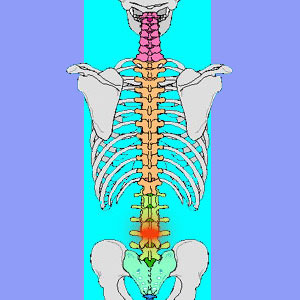
Sciatica L4 is a specific radiculopathy diagnosis which describes impingement upon or compression of the lumbar 4 spinal nerve root. L4 is one of the nerve roots which eventually join together to form the sciatic nerve. L4 is also a commonly implicated nerve in many lower back pain syndromes, due to its proximity to the spinal region which suffers the most degeneration in the human body.
This essay provides some important details on the L4 nerve compression diagnosis. We will discuss what is involved from a pinched L4 nerve and what the patient should expect from the condition.
Sciatica L4 Structural Implications
The L4 root exits the spine at the L4 vertebral level. This is part of the lower lumbar spine and is one of the most common regions to experience degenerative disc disease and herniated discs, as well as general spinal degeneration, including osteoarthritis.
L4 serves the neurological needs of much of the lower body, in a pattern beginning on the outer aspect of the upper thigh and tracing a diagonal line over the front of the knee, to the inside of the shin and calf to the big toe and frontal inner aspect of the foot.
Problems with the L4 spinal nerve root can cause pain, tingling, numbness and/or weakness in any or all areas served, making it a typical sciatic nerve pain pattern, most often concentrated in the inner ankle area.
Sciatica Lumbar 4 Anatomy
The L4 spinal nerve root joins up with the L5, S1, S2 and S3 nerves to create the sciatic nerve. This is the largest nerve in the body and has branches which descend down both legs. The sciatic nerve is also called the ischiatic nerve and is the main conduit for life energy to reach the entire lower anatomy. The sciatic is the neurological highway which creates a network of smaller peripheral nerves in the legs and lower body and is responsible for virtually all motor and sensory capabilities we feel in the lower anatomy.
When L4 is affected in the spinal column, the nerve messages to the served areas of the legs and feet may not reach their target destinations correctly. This can cause the perception of pain in the legs and/or feet, as well as the additional neurological symptoms detailed above. However, some patients also develop motor dysfunction, including the inability to move muscular sets correctly, or at all.
Sciatica L4 Mechanisms
Pinched nerves do happen in the spine, but they are far more rare than they are diagnosed. A herniated disc or osteoarthritis enacted osteophyte complex can impinge on a spinal nerve root, such as the L4, but in order for this to actually occur, virtually the entire neuroforaminal space would have to be closed off. However, it is crucial to remember that the cauda equina has already replaced the spinal cord at L4, so individual nerve roots can also be compressed within the central canal.
Regardless, many pinched nerves are misdiagnosed and often provide a structural scapegoat which receives treatment, preventing a continuing diagnostic evaluation which might lead to the discovery of the true symptomatic source.
While many patients suffer pain conditions which would seem appropriate for L4 nerve compression, others actually have symptoms which are far too widespread for single nerve root compression, as they endure symptoms in areas of the lower body not even served by L4. In these cases, the actual painful causation might be a higher level stenosis concern, a localized neuropathy, a pseudo-sciatica condition caused by the piriformis muscle, a disease process or even a regional oxygen deprivation syndrome. Patients are advised to consider all these possibilities if their symptoms do not correlate in location or expression.





